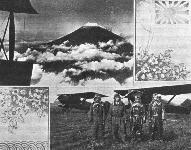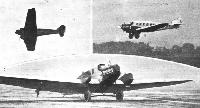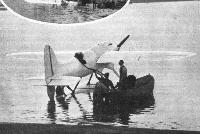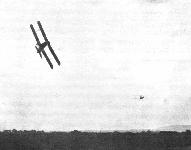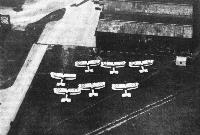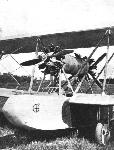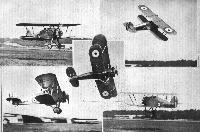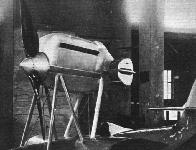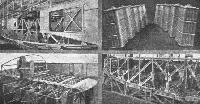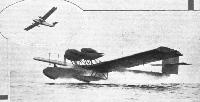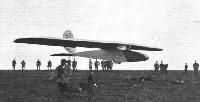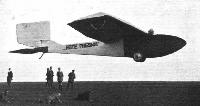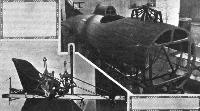Фотографии
-
THE TOKYO-LONDON FLIGHT: Having left the land of their sacred Fuji Yama last July, the four Japanese airmen shown above, Maj. Abe (extreme left) and Mr. Kawachi, the pilots, and Engineers Shinohara and Katagiri, are well on their way to London. The two Breguet biplanes on which they are flying will be seen behind the airmen, whilst above we show an aerial view of the beautiful Fuji Yama Mountain.
Самолёты на фотографии: Breguet Br.19 - Франция - 1922
-
Регистрационный номер: S-AAAT [3] THE JUNKERS G.24.L: This side view gives a good idea of the cabin, and the men standing in front of the machine give scale to the picture
Самолёты на фотографии: Junkers G 23 / G 24 - Германия - 1924
-
Регистрационный номер: S-AAAT [3] THE JUNKERS G.24.L: Three views of the machine, flying overhead, coming in to land, and taxi-ing up to the Customs House at Croydon.
Самолёты на фотографии: Junkers G 23 / G 24 - Германия - 1924
-
THE JUNKERS G.24.L: The view on the right shows the three Junkers L.2 engines and their housing. The top cover of the nose is shown raised for inspection of the engine. On the left is a view of the tail. Note the large horn balance of the elevator, and the negatively cambered tail plane.
Самолёты на фотографии: Junkers G 23 / G 24 - Германия - 1924
-
IN YET ANOTHER GUISE: The new Junkers G.23.W three-engined monoplane is produced as a land aeroplane with a variety of engines, according to whether it is to be used in restricted German air services or in other countries. It has now been successfully tested as a seaplane also, and is stated to get off very quickly. The machine here shown was built in Limhamn in Sweden under licence, and in one flight no less than 18 persons were carried. Like all other Junkers machines the G.23.W is of all-duralumin construction.
Самолёты на фотографии: Junkers G 23 / G 24 - Германия - 1924
-
Регистрационный номер: S-AAAT [3] THE JUNKERS G.24.L: Three-quarter rear view. Note how the wing engine cowling is faired into the wing surface
Самолёты на фотографии: Junkers G 23 / G 24 - Германия - 1924
-
THE JUNKERS G.24.L: This was the machine which recently brought over German bonds to the value of ?10,000,000. The three engines are Junkers L.2 developing 230 h.p. each.
Самолёты на фотографии: Junkers G 23 / G 24 - Германия - 1924
-
ANOTHER DUTCH WORLD'S RECORD: This photograph shows the latest Fokker F.VII commercial aeroplane, with 400 h.p. "Liberty" engine, on which the Fokker pilot, Grase, established, on July 27, a world's record for duration, with a useful load of 1,500 kgs. (3,300 lbs.), by flying for 3 hours 3 1/2 mins. This flight has been recognised by the F.A.I, as a world's record, and also beats the world's duration record for useful load of 1,000 kgs. The previous world's records were held by Lieut. J. A. McReady, of the U.S. Air Service, with 2 Hours 14 mins.
Самолёты на фотографии: Fokker F.VII / C-2 / F.XIV - Нидерланды - 1924
-
FIRST THREE-ENGINED FOKKER MONOPLANE: This is a development of the well-known type F.VII. The engines fitted are Wright "Whirlwinds," but if desired Armstrong-Siddeley "Lynx" engines can be substituted.
Самолёты на фотографии: Fokker F.VII / C-2 / F.XIV - Нидерланды - 1924
-
THE THREE-ENGINED FOKKER MONOPLANE IN FLIGHT: The machine is capable of flying on any two of its engines.
Самолёты на фотографии: Fokker F.VII / C-2 / F.XIV - Нидерланды - 1924
-
Регистрационный номер: G-EBCP WORLD'S LARGEST PASSENGER AEROPLANE: The Vickers "Vanguard," which is shortly to be handed over to Imperial Airways, Ltd., has accommodation for 20 passengers and luggage. The wing span is a little over 87 ft., and the length is 60 ft. Carrying a useful load of approximately two tons, the machine has a cruising speed of 100 m.p.h. The two engines are Rolls-Royce "Condors" of 650 h.p. each.
Самолёты на фотографии: Vickers Vanguard / Type 62 / Type 103 - Великобритания - 1923
-
Регистрационный номер: G-EBDP JOY FLIPS IN THE COUNTRY: For some time past the Surrey Flying Services have been giving exhibition and passenger flights near various provincial towns. Above we show three views taken at Grove Park, Kent, where Capt. Muir recently had a couple of Avro 504K's hard at work. Besides "stunt" flying, including parachute jumps and "wing walking," many passengers were taken up for 3-minute flights at 5s. a head. Capt. Muir can be seen standing in front of the machine in the lower photograph.
Самолёты на фотографии: Avro Avro 504 - Великобритания - 1913
-
THE SCHNEIDER CUP RACE: View of the Supermarine-Napier S.4 monoplane. This official photograph do not do justice to the machine, which is of exceptionally pleasing lines and of very clean design. The under-carriage is unbraced, the four steel tube struts being cantilevers, which provide a considerable amount of springing of the floats.
Самолёты на фотографии: Supermarine S.4 - Великобритания - 1925
-
THE SCHNEIDER CUP RACE: View of the Supermarine-Napier S.4 monoplane.
Самолёты на фотографии: Supermarine S.4 - Великобритания - 1925
-
THE SCHNEIDER CUP RACE: View of the Supermarine-Napier S.4 monoplane. In the photograph the tube leading to the pilot's cockpit is the lead from the Bristol starter engine by means of which the Napier engine is started.
Самолёты на фотографии: Supermarine S.4 - Великобритания - 1925
-
MANOEUVRABILITY: Two De Havilland "Moths" racing at Lympne during the August meeting. The leading machine is being piloted by Cobham, and that in the background by Broad.
Самолёты на фотографии: De Havilland Moth / D.H.60 - Великобритания - 1925
-
"BISONS" BROWSING AT BROUGH: This photograph, taken from the air, shows a fleet of Avro "Bison" machines at the Brough aerodrome. The "Bison" was designed and constructed by A. V. Roe and Co. as a Fleet gunnery spotter, and is fitted with a Napier "Lion" engine. The machine is equipped for taking off from, and alighting on, the deck of a vessel.
Самолёты на фотографии: Avro Bison / Type 555 - Великобритания - 1921
-
THE CAPRONI 80: A night-bomber fitted with two Bristol "Jupiters" mounted in tandem. Three-quarter front view.
Самолёты на фотографии: Caproni Ca.73 / Ca.80 - Италия - 1924
-
THE CAPRONI 80: View showing mounting of the two Bristol "Jupiter" engines. The petrol tanks are placed between the engines.
Самолёты на фотографии: Caproni Ca.73 / Ca.80 - Италия - 1924
-
THE CAPRONI 80: This front view gives an excellent idea of the slope of the inter-plane struts.
Самолёты на фотографии: Caproni Ca.73 / Ca.80 - Италия - 1924
-
THE CAPRONI 80 NIGHT-BOMBER: Side view.
Самолёты на фотографии: Caproni Ca.73 / Ca.80 - Италия - 1924
-
THE SCHNEIDER CUP RACE: These three views of the Gloster-Napier III give a reasonably good idea of the clean lines of Mr. Folland's design. The special Napier racing engine is totally cowled-in, and streamlining generally has been carried out to the greatest possible extent. At the top is a view of the machine taking off.
Самолёты на фотографии: Gloster I - III - Великобритания - 1923
-
Регистрационный номер: J6989 [2] THE HAWKER "HERON": These views, taken at Brooklands recently, show the machine in various attitudes. Considering the speed at which the machine flies, the quality of these photographs is, we think, quite exceptionally good. The pilot was Flight Lieutenant Bulman.
Самолёты на фотографии: Hawker Heron / Hornbill / Hawfinch / Hoopoe - Великобритания - 1925
-
Регистрационный номер: J6989 [2] THE HAWKER "HERON": Built for the Air Ministry, the Hawker "Heron" is a single-seater fighter, fitted with Bristol "Jupiter" engine. The machine not yet having been put into quantity production no details may be given, other than those which may be gathered from an inspection of the photographs. The "Heron," designed and built by the Hawker Engineering Company, has a remarkable climb, but actual figures may not yet be published.
Самолёты на фотографии: Hawker Heron / Hornbill / Hawfinch / Hoopoe - Великобритания - 1925
-
The Schneider Cup Race: View of the Curtiss engine installation in the Macchi Flying Boat. Note the position of the radiators near the tail of the engine nacelle. A portion of the wing built integral with the hull may be seen.
Самолёты на фотографии: Macchi M.33 - Италия - 1925
-
Two views of the P.N.9 twin-engined flying boat, one of which made such a remarkable flight last week from San Francisco to the Hawaiian Islands.
Самолёты на фотографии: Naval Aircraft Factory PN - США - 1922
-
Some constructional details of the P.N.-9 flying boat. On the left, (top) metal keel-sponson frame, (bottom) tail group. On the right, (top) the aluminium-alloy petrol tanks, (bottom) forward portion of the metal hull frame.
Самолёты на фотографии: Naval Aircraft Factory PN - США - 1922
-
THE SUPERMARINE "SOUTHAMPTON": Note the clean running of the machine, reference to which was made in the paper read by Mr. Simmonds. The engines are Napier "Lions."
Самолёты на фотографии: Supermarine Southampton / Solent - Великобритания - 1925
-
The Rohrbach Ro.II taxying; Inset a view of the machine in flight.
Самолёты на фотографии: Rohrbach Ro.II - Ro.IV - Германия - 1923
-
Регистрационный номер: N183 [2] THE BEARDMORE-ROHRBACH "INVERNESS" FLYING BOAT: View of the machine taken shortly after its arrival from Copenhagen.
Самолёты на фотографии: Rohrbach Ro.II - Ro.IV - Германия - 1923
-
Регистрационный номер: N183 [2] The Beardmore-Rohrbach "Inverness." View of the nacelles housing the Napier "Lion" engines.
Самолёты на фотографии: Rohrbach Ro.II - Ro.IV - Германия - 1923
-
TWO VIEWS IN THE PANDER WORKS AT THE HAGUE: On the left, fuselages, wings, etc., of the Pander monoplane. On the right, a single-seater fuselage and one of the wings of the two-seater, which is now nearing completion.
Самолёты на фотографии: Holland (VIH) H.2 - Нидерланды - 1924
-
SOME DETAILS OF PANDER CONSTRUCTION: On the left, a fuselage, upside down, on its trestles, showing the keel and diagonal' members of the structure. On the right, a wing, also upside down, showing spars, ribs, etc. The wing tip rib is of U-section, and built up from numerous laminations. On the top surface the ply-wood covering of the leading edge extends a considerable distance aft of the front spar.
Самолёты на фотографии: Holland (VIH) H.2 - Нидерланды - 1924
-
In the Rhon: The Russian glider "Moscow" taking off.
Самолёты на фотографии: Ильюшин, Леонтьев, Курин АВФ-21 Москва - Россия - 1925
-
In the Rhon: Added interest is lent to this year's Rhon meeting by the fact that several Russian gliders are taking part. The one here shown is known as the "Rote Presnia"
Самолёты на фотографии: Артамонов И. АВФ-23 Красная Пресня - Россия - 1925
-
The Piero Magni "Vittoria 1924" Sesquiplane: About to start on its first flight (October 22, 1924), piloted by its designer. This machine is fitted with a 50 h.p. Anzani 6-A.20, and has movable auxiliary planes forming the main wing struts.
Самолёты на фотографии: Magni PM.1 / PM.2 Vittoria - Италия - 1924
-
THE PIERO MAGNI "VITTORIA 1924" SESQUIPLANE: At the top is a view of the partly-covered fuselage, showing the triangular steel frame support for the main planes. Below is the pilot's control, the two side levers operating the auxiliary wings.
Самолёты на фотографии: Magni PM.1 / PM.2 Vittoria - Италия - 1924
-
THE PIERO MAGNI "VITTORIA 1924" SESQUIPLANE: Some constructional details. On the left (top) the main starboard wing in skeleton, and below the fuselage frame, which is covered with plywood. On the right will be seen one of the auxiliary wings (top) and the tail plane, or elevator.
Самолёты на фотографии: Magni PM.1 / PM.2 Vittoria - Италия - 1924
-
The Piero Magni "Vittoria 1924" Sesquiplane: Another view, showing the cowling removed from the Anzani engine; the covering over the main wing attachment of the auxiliary wing strut is also removed.
Самолёты на фотографии: Magni PM.1 / PM.2 Vittoria - Италия - 1924
-
A model of the first, 1919-a, type "Vittoria" sport 'plane (50 h.p. Gnome), showing (left) the auxiliary wings in normal flying position, and (right) in air-brake position.
Самолёты на фотографии: Magni PM.1 / PM.2 Vittoria - Италия - 1924
-
Piero Magni "Vittoria 1924" Sesquiplane 50 hp. Anzani 6-A.20
Самолёты на фотографии: Magni PM.1 / PM.2 Vittoria - Италия - 1924
-
A KOOLHOVEN SCHOOL MACHINE: The F.K.32 is a school machine of rather unusual design, the main features of which are absence of wing bracing and extremely wide wheel track. Two gravity feed petrol tanks are mounted in the top plane. Note the peculiar scoop on the side of the fuselage, which allows the air from the engine cowling to flow back past the cockpits. The machine depicted has a rotary engine, but a similar type can be supplied fitted with Bristol "Lucifer."
Самолёты на фотографии: Koolhoven FK-32 - Нидерланды - 1924
Статьи
- Flight
